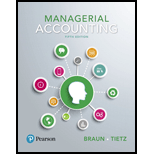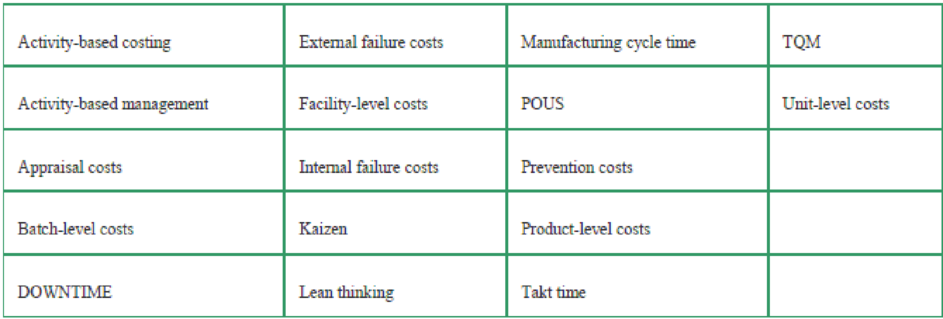
Managerial Accounting Plus Mylab Accounting With Pearson Etext -- Access Card Package (5th Edition)
5th Edition
ISBN: 9780134641805
Author: Braun
Publisher: PEARSON
expand_more
expand_more
format_list_bulleted
Textbook Question
Chapter 4, Problem 4.1SE
Understanding key terms (Learning Objectives 1, 2, 3, 4, & 5)
The following is a list of several terms. Complete each of the following statements with one of these terms. You may use a term more than once, and some terms may not be used at all.

- a. The time that elapses between the start of production and the product’s completion is known as _____.
- b. _____ is the management philosophy and strategy focused on creating value for the customer by eliminating waste.
- c. The costs incurred for every batch, regardless of the number of units in the batch, are known as _____.
- d. Costs incurred to avoid poor-quality goods or services are _____.
- e. Using activity-based costing information to make decisions that increase profits while satisfying customers’ needs is _____.
- f. An acronym for the eight wastes is _____.
- g. The costs incurred for a particular product, regardless of the number of units or batches of the product produced, are known as _____.
- h. _____focuses on activities as fundamental building blocks in compiling the indirect costs of products, services, and customers.
- i. _____are costs incurred when defects in poor-quality goods or services are corrected before making delivery to customers.
- j. _____are incurred for every single unit of product produced.
- k. Costs incurred when the company does not detect poor-quality goods or services until after delivery is made to customers are _____.
- l. _____are costs incurred no matter how many units, batches, or products are produced.
- m. _____is a Japanese word meaning “change for the better.”
- n. Costs incurred to detect poor-quality goods or services are _____.
- ○. The rate of production needed to meet customer demand, yet avoid overproduction, is known as _____.
- p. _____is a storage system used to reduce the waste of transportation and movement, in which tools, materials, and equipment are stored in proximity to where they will be used most frequently.
- q. _____is a management philosophy of delighting customers with superior products and services by continually setting higher goals and improving every business function.
Expert Solution & Answer
Want to see the full answer?
Check out a sample textbook solution
Students have asked these similar questions
Additionally, regarding the project, please do not assume that the reader is familiar with the subject areas that you are writing about. Therefore, definitions, assumptions, facts, and analyses are required in this assignment.
Further, there are four questions that are being asked. Three questions need supporting calculations to validate your answers. Please help me by showing the calculations and assumptions in each of the answers, otherwise I will receive an 0. Kindly show your calculations. Also, a review of Learning Objective 4 in chapter 21 would be a good place to start with this assignment (Lease Capitalization, Bargain purchase Option.) Below are the questions for your convenience.
What ethical issue is at stake?
Should the controller's argument be accepted if she does not really know much about copier technology? Would it make a difference if the controller were knowledgeable about the rate of change in copier technology?
What should Suffolk do?
List the business, technological, and organizational challenges that were addressed throughout the project to implement a new learning management system, and explain the three-sphere model for systems management in your own words. Do not depend on the examples in the textbook.
Click to watch the Tell Me More Learning Objective 1 video and then answer the questions below.
Chapter 4 Solutions
Managerial Accounting Plus Mylab Accounting With Pearson Etext -- Access Card Package (5th Edition)
Ch. 4 - (Learning Objective 1) Cost distortion is more...Ch. 4 - (Learning Objective 2) The first step in computing...Ch. 4 - (Learning Objective 2) Activities incurred...Ch. 4 - (Learning Objective 3) Which of the following is...Ch. 4 - (Learning Objective 3) The potential benefits of...Ch. 4 - (Learning Objective 4) Lean operations are...Ch. 4 - Prob. 7QCCh. 4 - (Learning Objective 4) Concerning lean operations,...Ch. 4 - (Learning Objective 5) Which of the following is...Ch. 4 - (Learning Objective 5) Which of the following...
Ch. 4 - Understanding key terms (Learning Objectives 1, 2,...Ch. 4 - Use departmental overhead rates to allocate...Ch. 4 - Compute departmental overhead rates (Learning...Ch. 4 - Prob. 4.4SECh. 4 - Prob. 4.5SECh. 4 - Calculate a job cost using ABC (Learning Objective...Ch. 4 - Classifying costs within the cost hierarchy...Ch. 4 - Classifying costs within the cost hierarchy...Ch. 4 - Determine the usefulness of refined costing...Ch. 4 - Prob. 4.10SECh. 4 - Identifying costs as value-added or...Ch. 4 - Identify lean production characteristics (Learning...Ch. 4 - Identify the DOWNTIME activities at a manufacturer...Ch. 4 - Prob. 4.14SECh. 4 - Classifying costs of quality (Learning Objective...Ch. 4 - Quality initiative decision (Learning Objective 5)...Ch. 4 - Assess the impact of a quality initiative...Ch. 4 - Identify ethical standards violated (Learning...Ch. 4 - Compare traditional and departmental cost...Ch. 4 - Compute activity rates and apply to jobs (Learning...Ch. 4 - Apply activity cost allocation rates (Learning...Ch. 4 - Using ABC to bill clients at a service firm...Ch. 4 - Compare traditional and ABC allocations at a...Ch. 4 - Compare traditional and ABC allocations on a job...Ch. 4 - Use ABC to allocate manufacturing overhead...Ch. 4 - Continuation of E4-25A: Determine product...Ch. 4 - Prob. 4.27AECh. 4 - Classify costs and make a quality-initiative...Ch. 4 - Prob. 4.29AECh. 4 - Compare traditional and departmental cost...Ch. 4 - Prob. 4.31BECh. 4 - Prob. 4.32BECh. 4 - Prob. 4.33BECh. 4 - Compare traditional and ABC cost allocations at a...Ch. 4 - Prob. 4.35BECh. 4 - Prob. 4.36BECh. 4 - Prob. 4.37BECh. 4 - Prob. 4.38BECh. 4 - Classify costs and make a quality-initiative...Ch. 4 - Prob. 4.40BECh. 4 - Prob. 4.41APCh. 4 - Use ABC to compute full product costs (Learning...Ch. 4 - Prob. 4.43APCh. 4 - Prob. 4.44APCh. 4 - Prob. 4.45APCh. 4 - Prob. 4.46BPCh. 4 - Prob. 4.47BPCh. 4 - Comprehensive ABC implementation (Learning...Ch. 4 - Using ABC in conjunction with quality decisions...Ch. 4 - Comprehensive ABC (Learning Objectives 2 3)...Ch. 4 - Prob. 4.51SCCh. 4 - Discussion Questions 1. Explain why departmental...Ch. 4 - ABC in Real Companies Choose a company in any of...Ch. 4 - Value-Added versus Non-Value-Added at a Restaurant...Ch. 4 - Ethics involved with ABC and hazardous waste costs...
Knowledge Booster
Learn more about
Need a deep-dive on the concept behind this application? Look no further. Learn more about this topic, accounting and related others by exploring similar questions and additional content below.Similar questions
- Ethics case: Uncollectible Accounts Introduction The purpose of this discussion forum is to give you an opportunity to apply your critical-thinking ability to the knowledge you’ve gained. The assignment provides you with an opportunity to develop your research, analysis, judgment, and communication skills. You also will work with other students, integrate what you’ve learned, apply it in real-world situations. This practice will broaden your knowledge and further develop your decision-making abilities. The assignment achieves learning objective 5. The assignment information is given below; You have recently been hired as the assistant controller for Stanton Industries, a large, publicly held manufacturing company. Your immediate superior is the controller who, in turn, is responsible to the vice president of finance. The controller has assigned you the task of preparing the year-end adjusting entries. In the receivables area, you have prepared an aging of accounts receivable and have…arrow_forwardgive three academic skills that student developed being in HE (Higher Education). Reflect on learning experience and use Gibbs’ model of reflection.arrow_forwardWhy is SMART goals a good example of one’s learning of that particular unit and topic. Please reference specific skill/knowledge acquired when completing this sectionarrow_forward
- You are the floor manager of Channel and have read the following learning outcomes: “Purchase Returns and Allowances”, “Customer Refunds and Allowances”, and “Merchandise Returns” (pg 149 – 155). As the manager, briefly explain the difference between Purchase Returns and Allowances and Merchandise Returns. Customer Refunds and Customer Allowances.arrow_forwardPart One: Indicate whether the following sentences are true or false: In the system perspective of the learning organization, Senge's five disciplines include interrelationships between the organizational events and processes, team learning, shared vision, shared mental models, and personal mastery.arrow_forwardWhat is a SMART goal? Why should someone use this method? Why it it a good example of one’s learning of that particular unit and topic. Please reference specific skill/knowledge acquired when completing this sectionarrow_forward
- Creative thinking is the ability to look at things differently, and find new ways of solving problems. How does the Accountancy course sharpen your creative thinking? Answer in 1 sentence onlyarrow_forwardS15-8 Identify ethical standards violated (Learning Objectives 1, 2, & 3) For each of the situations listed, identify the primary standard from the IMA Statement of Ethical Professional Practice that is violated (competence, confidentiality, integrity, or credibility). Refer to Exhibit 1-7 for the complete standard. Chris is asked to prepare the GRI report for the year, but he has not attended GRI training. He decides to muddle his way through the report. George is frustrated because he feels that his company is not moving fast enough to adopt sustainable practices and GRI reporting. He talks to a reporter about some potential environmental fines the company might receive, thinking that if the company is embarrassed publicly, it will move faster on sustainability initiatives. Kayleigh does not disclose that her brother is the president of the consulting firm her organization is hiring for some GRI reporting work. Cynthia is a staff accountant at Briar Industries. Since Briar's GRI…arrow_forwardDo you have the work sheet and financial statement for the attached homework. Critical thinking problem 5.2 Worksheet and Financial Statement?arrow_forward
- You are the floor manager of Channel and have read the following learning outcomes: “Purchase Returns and Allowances”, “Customer Refunds and Allowances”, and “Merchandise Returns” (pg 149 – 155). As the manager, briefly explain the difference between Purchase Returns and Allowances and Merchandise Returns. Customer Refunds and Customer Allowances. Explain the difference between FOB Shipping Point and FOB Destination.arrow_forwardAssume you are the manager responsible for implementing a new service. The time to perform the service is subject to the learning curve. Would you prefer that the new service have a learning rate of 85 percent or 80 percent? Why?arrow_forward1. Journal all transactions in Part One 2. Using the chart of accounts, open ledger accounts and post journals to the ledger account. 3. Prepare a trial balance 4. Prepare the following statements: 1. Income Statement 2. Retained Earnings Statements 3. Balance Sheet You need to use Microsoft Excel. Do not use Google Docs or Apple’s numbers. Place your submission in the appropriate journal labeled final project in the learning modules tab in Blackboard. The project is due in Module 15. Three points extra credit to final grade if submitted during Module 14. Part One A. The following transaction occurred for Scrooge Inc. for the month of December 31, 1820. B. Ebenezer Scrooge invested $50,000 cash along in the company in exchange for common stock. C. The company prepaid $500 for 12 month’s rent. D. The company purchased $100 in office supplies. Payment due withing 10 days E. Scrooge Inc. completed services for a client and immediately received $2,000. F. The company completed $1,500…arrow_forward
arrow_back_ios
SEE MORE QUESTIONS
arrow_forward_ios
Recommended textbooks for you
 Cornerstones of Cost Management (Cornerstones Ser...AccountingISBN:9781305970663Author:Don R. Hansen, Maryanne M. MowenPublisher:Cengage Learning
Cornerstones of Cost Management (Cornerstones Ser...AccountingISBN:9781305970663Author:Don R. Hansen, Maryanne M. MowenPublisher:Cengage Learning

Cornerstones of Cost Management (Cornerstones Ser...
Accounting
ISBN:9781305970663
Author:Don R. Hansen, Maryanne M. Mowen
Publisher:Cengage Learning

What is Business Analysis?; Author: WolvesAndFinance;https://www.youtube.com/watch?v=gG2WpW3sr6k;License: Standard Youtube License